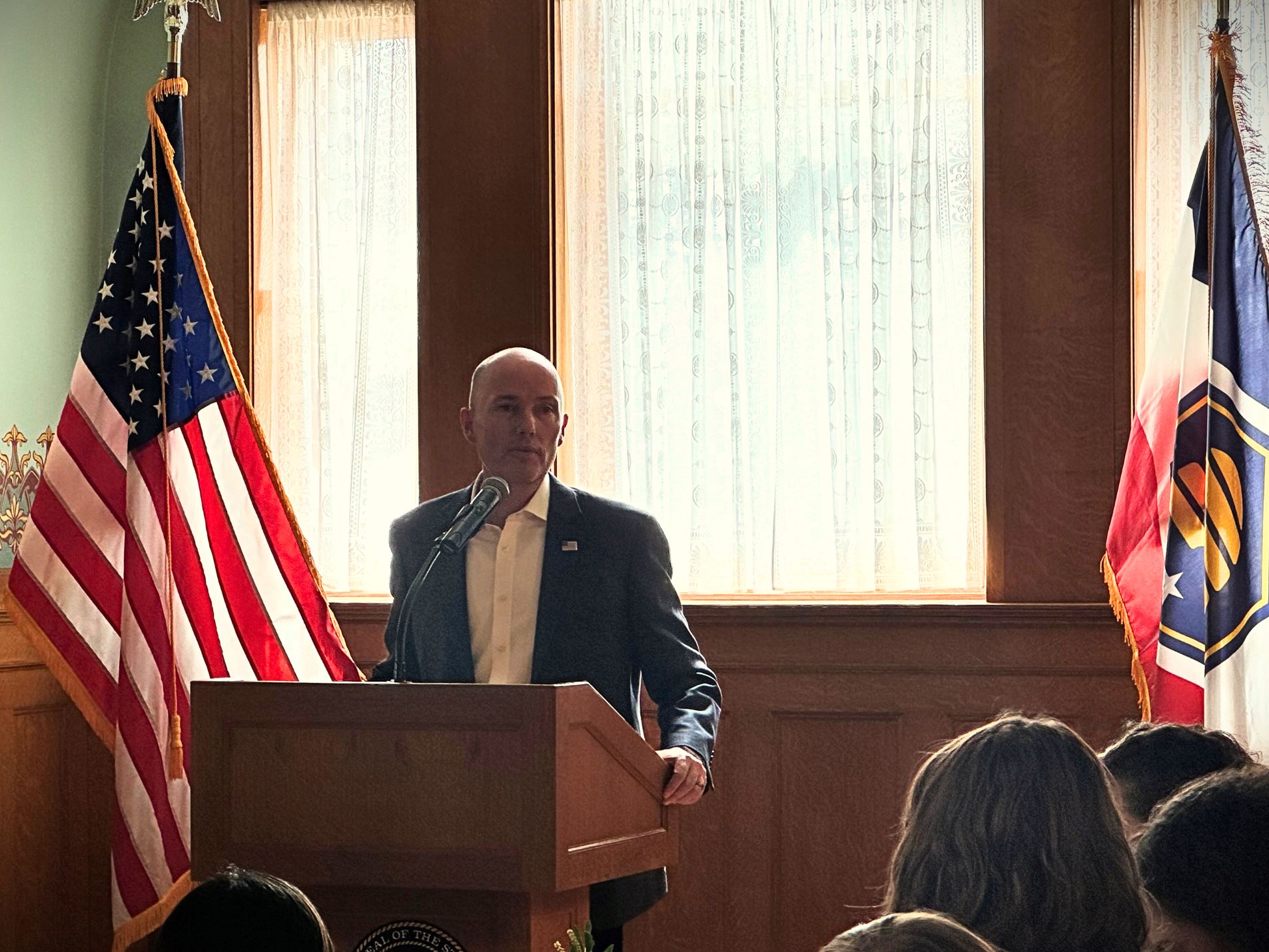Good morning Chairman Enzi, Senator Kennedy, and members of the Committee. I am Ernie Fletcher, Governor of the Commonwealth of Kentucky, and I’d like to thank you for the invitation to testify on behalf of the nation’s governors regarding lifelong education. As Governor Sebelius has discussed, governors are eager to align preschool-college education systems to promote lifelong learning and to ensure American business and workers can remain competitive.
High schools are our nation’s front line in the battle to restore America’s global competitiveness. High school completion is the first step in the earnings and skill ladder and the bridge to postsecondary education, work readiness, and lifelong learning.
A Call to Action
For more than a century, our nation’s high schools fulfilled this task and prepared students for good jobs at decent wages. As you already heard from Secretary Spellings, the legacy of our nation’s high schools is in jeopardy – too many of our nation’s youth are dropping out of high school and too many high school graduates are unprepared for the demands of postsecondary education or work.
Three out of ten students who enter high school do not graduate. Four out of ten who graduate lack the skills and knowledge required to go to college or succeed in the workforce. Five out of ten who go to college do not finish.[1]
Our high school students’ lack of preparation has serious implications for our economy and prosperity. Every year taxpayers pay $1 billion to $2 billion to fund remedial education to students at public universities and colleges.[2] Shortfalls in basic skills cost businesses, colleges and under-prepared high school graduates, as much as $16 billion annually in lost productivity and remedial costs.[3]
Our nation has a powerful incentive to plug the leaks in the education pipeline. In the next decade, two-thirds of new jobs will require some postsecondary education beyond a high school degree. To be competitive and create the conditions for strong economic growth, states need to help all their residents increase their skills and be prepared for lifelong learning. Much is at stake.
NGA “Redesigning the American High School”
Governors are working to improve the high school experience to ensure that our students are ready to earn and learn well beyond graduation day. Under the leadership of NGA’s Chairman, Virginia Governor Mark Warner, NGA launched an initiative – “Redesigning the American High School” – to spur state action and systemically change high schools. As part of the Chairman’s initiative, NGA:
- Convened governors advisors from over 30 states to develop an understanding of the diverse problems in high schools and increased awareness of promising state best practices;
- Developed several publications such as Getting it Done: Ten Steps to a State Action Agenda to provide governors with concrete strategies to begin redesigning their high schools (the full text of the document is attached); and
- Convened town hall meetings in Cleveland, Ohio, Conway, Arkansas, and Norfolk, Virginia to listen to students’ suggestions on what governors can do to improve their state’s high schools. Three additional town hall meetings are scheduled to take place in Baton Rouge, Louisiana, Portland, Maine, and Des Moines, Iowa.
As a result of these efforts 26 governors made high school reform a priority in this year’s state of the state addresses.
2005 National Education Summit on High School
Most recently, NGA and Achieve convened the 2005 National Education Summit on High Schools. The summit addressed such core high school reform issues as strengthening high school graduation requirements, expanding options and supports for students to achieve higher standards, improving teaching and principal leadership, and strengthening high school and college data and accountability systems.
An Action Agenda for Improving America’s High Schools was released at the summit. The publication provides states with a framework to build their high school agendas. The framework calls for:
- Restoring Value to the High School Diploma by anchoring high school academic standards in the real world; upgrading high school coursework, and creating college and work ready tests.
- Redesigning High Schools by reorganizing low-performing high schools first; expanding school options in all communities; and providing support to low-performing schools.
- Giving High School Students the Excellent Teachers and Principals They Need by improving teacher knowledge and skills; providing incentives to recruit and keep teachers where they are needed most, and developing and supporting strong principal leadership.
- Setting Goals, Measuring Progress, and Holding High Schools and College Accountable by strengthening high school accountability, intervening in low-performing high schools, and strengthening postsecondary accountability.
- Streamlining and Improving Education Governance by building a stronger working relationship between elementary, secondary and postsecondary education.
Nearly 50 governors took part in the Summit, which marked the fifth time since 1989 that governors, CEOs and education leaders gathered to address the urgent needs of America’s educational system.
High School Reform “Getting It Done”
At the close of the NGA Winter Meeting and High School Summit, governors returned to their states with high school action plans in hand. Some governors will take immediate action to expand college-level learning opportunities in high schools, or fund supports to help students pass their high school exit exam. Other governors will develop long-term plans for aligning high school standards with the expectations of employers or universities to ensure that high quality teachers and principals teach in the neediest high schools.
To ensure that “Redesigning the American High School” became a reality, NGA and five partner foundations – the Bill & Melinda Gates Foundation, the Michael & Susan Dell Foundation, The Wallace Foundation, The Prudential Foundation and the State Farm Foundation – joined forces and announced a $42 million initiative to translate Summit discussions into state action to help states create and implement policy strategies to improve graduation and college-readiness rates. In addition, NGA’s Center is also exploring partnerships with the GE Fund, Ewing Marion Kauffman Foundation, The Lumina Foundation, and the Bell South Foundation. This month, NGA released a Request for Proposals to all states interested in creating a high school redesign agenda.
NGA High School Reform Recommendations
Governors would like to partner with Congress and the Administration to accelerate our high school redesign action plans. Governors are leading innovative high school redesign across the nation. Let me point to several specific ways that states are reforming high schools and how federal policy can help spur state innovation and best practices:
- States are creating different high school models that strengthen student relationships with adults; connect classroom work to real-life problems; and improve connections to postsecondary education.
- Congress can support state reform by lifting burdensome reporting requirements and allowing Governors greater flexibility to coordinate funds. Congress should provide greater gubernatorial authority to coordinate federal funds within education programs and across grade levels to better serve students’ unique and diverse needs.
- The Senate’s recent action to reauthorize and improve the Vocational Education Act will assist in this endeavor. Perkins is an important component of high school reform. Career and technical education can bridge the transition between high school and postsecondary education by providing students with real-world skills to better prepare for the 21st century workplace. Perkins should improve the academic rigor and preparation of career and technical education for all students.
- States are expanding high school opportunities that increase rigor and relevance of high school for all students.
- During the reauthorization of HEA and WIA, Congress should support expanded opportunities for students to participate in advanced placement, international baccalaureate, early college, industry certification programs, distance-learning, and the State Scholars Program. State innovation can be further supported by providing greater flexibility in student financial aid eligibility requirements. Congress should also encourage and provide incentives to states to create dual enrollment programs that permit students to obtain college-level credits or provide the opportunity to earn an industry-recognized credential while still in secondary school.
- States are developing new targeted recruitment incentives to attract teachers where they are needed most, and provide support to retain them. States are also working to improve principal recruitment, preparation, and professional development.
- Congress should provide additional flexibility and incentives to support this critical work by expanding professional development and piloting alternative teacher compensation models. Loan forgiveness should be permanently expanded from $5,000 to $17,500 to recruit teachers into critical shortage areas and hard-to-staff schools.
- States are developing more rigorous standards for teacher preparation and performance. Governors are committed to improving high school students’ academic proficiency with stronger teaching.
- Congress can encourage state innovation and continuous improvement by deferring national one-size-fits-all benchmarks and allowing states time to refine their teacher preparation programs. In addition, Congress should work with Governors during HEA reauthorization to expand state accountability for teacher preparation programs to align with the rigorous requirements of NCLB.
- States are investing more resources into need based aid to make college an option.
- Federal policies to increase preparation and learning opportunities should be matched with additional flexibility and affordability in higher education. To help make college more affordable, Congress should consider raising the maximum Pell grant award and provide new flexibility to respond to students’ needs, including extending eligibility beyond the typical calendar year. In addition, student financial aid guidelines should be revised to better serve nontraditional students and working adults. These reforms should be enacted in HEA.
- States are improving college and work-readiness assessments in high schools.
- Across the country, Governors have made considerable progress to institute state-based accountability in K-12 education. Governors are also working hard to implement NCLB, which expanded high school accountability by requiring states to test students at least once in grades 10-12.
- Governors urge Congress to closely consult with states on any federal expansion of testing and to continue to respect Governors’ authority over education. Any costs associated with federally mandated testing or federal reporting on state exams must be completely covered by the federal government. Maximum flexibility in designing state accountability systems, including testing and other assessments, is critical to preserve the unique balance involving federal funding, local control of education, and state responsibility for system-wide reform. Maximum flexibility in state testing will also help improve how students are assessed for academic proficiency and postsecondary readiness.
Conclusion
Working with businesses, education leaders, parents and students, governors understand the unique challenges our nation faces in redesigning high schools. Governors also understand how much state flexibility is required to develop and implement meaningful solutions. There are no easy answers. Every child, every teacher, every school, and every state is different. Governors hope to forge a new federal-state partnership that strengthens state ingenuity and innovation.
Our nation must not fail to provide students with the foundation for lifelong learning – the cost to our children and our nation is too high. The nation’s governors stand ready to work with you to create a common vision to support lifelong learning and redesign our nation’s high schools.
[1] National Center for Public Policy and Higher Education, Policy Alert: The Educational Pipeline: Big Investments, Big Returns (San Jose, Calif.: National Center for Public Policy and Higher Education, 2004), at http://www.highereducation.org/reports/pipeline/pipeline.pdf.
[2] David Breneman and William Haarlow, Remediation in Higher Education (Washington, D.C.: Thomas B. Fordham Foundation, July 1998); and Ronald Phipps, College Remediation: What It IS, What It Costs, What’s at Stake (Washington, D.C.: Institute for Higher Education Policy, December 1998.) An Action Agenda for Improving America’s High Schools: 2005 National Education Summit on High School (Washington, D.C., February 2005).
[3] Jay P.Greene, The Cost of Remedial Education: Who Much Michigan Pays When Students Fail to Learn Basic Skills (Midland, Michigan: Mackinac Center for Public Policy, 2000). An Action Agenda for Improving America’s High Schools: 2005 National Education Summit on High School (Washington, D.C., February 2005).












